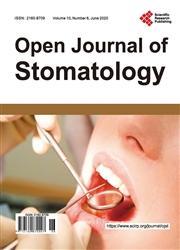Periodontal Health among Type 2 Diabetes Patients Treated with Different Dental Restorations
引用次数: 0
Abstract
Background: Diabetes increases periodontal disease risk and its complications, which are worsened with age or faulty restorations. Aim: Evaluate periodontal health among patients with diabetes treated with different dental restorations. Materials and Methods: This comparative cross-sectional study was conducted at the faculty of dentistry, Najran University, KSA, from March 2018 to February 2020. It included 260 diabetics, treated with different dental restorations, divided into four groups, each comprising 65 patients aged 45 - 60 years: Group 1 (G1), no restorations (control group); Group 2 (G2), Class II amalgam restorations; Group 3 (G3), Class II composite resin restorations; and Group 4 (G4), three-unit posterior metal ceramic prostheses. The Ages of all restorations ranged from 8 to 10 years. All groups were assessed for the Plaque Index (PI) and Gingival Index (GI), Overhangs Rate (OR), Alveolar Bone Loss (ABL) (the latter two using panoramic X-ray). HbA1c and duration of participants were also assessed and compared. Results: The mean HbA1c results of the groups ranged from 8.1% to 9.5%, and their mean diabetes durations ranged from 7.2 to 12 years. All the groups showed worse periodontal scores, ranging from 2.45 - 2.95 for PI and 2.25 - 2.8 for GI. G2 had higher scores than G1 and G3 (p p p p = 0.987). The highest value was observed in G4, which was significantly higher than other groups (p < 0.001). Conclusion: The worse periodontal parameters among subjects treated with either three-unit metal ceramic or Class II amalgam restorations indicated severe periodontal destruction. Untreated subjects and subjects treated with Class II composite resin had relatively better periodontal status.不同修复方式治疗2型糖尿病患者的牙周健康状况
背景:糖尿病会增加牙周病及其并发症的风险,而这些风险会随着年龄的增长或修复不良而恶化。目的:评价不同牙修复体治疗的糖尿病患者的牙周健康状况。材料和方法:这项横断面比较研究于2018年3月至2020年2月在KSA纳格兰大学牙科学院进行。研究包括260名糖尿病患者,他们接受了不同的牙齿修复治疗,分为四组,每组65名年龄在45-60岁之间的患者:第一组(G1),不进行修复(对照组);第2组(G2),II级汞合金修复体;第3组(G3),Ⅱ类复合树脂修复体;第4组(G4),三个单元的后部金属陶瓷假体。所有修复体的年龄从8岁到10岁不等。评估所有组的牙菌斑指数(PI)和牙龈指数(GI)、上翘率(OR)、牙槽骨丢失(ABL)(后两组使用全景X射线)。还对参与者的HbA1c和持续时间进行了评估和比较。结果:两组的平均HbA1c结果在8.1%-9.5%之间,平均糖尿病持续时间在7.2-12年之间。所有组的牙周评分均较差,PI评分在2.45-2.95之间,GI评分在2.25-2.8之间。G2的评分高于G1和G3(p p p=0.987)。G4的评分最高,结论:三元金属陶瓷或II类汞合金修复体的牙周参数较差,表明牙周破坏严重。未治疗的受试者和用II类复合树脂治疗的受检者的牙周状况相对较好。
本文章由计算机程序翻译,如有差异,请以英文原文为准。
求助全文
约1分钟内获得全文
求助全文

 求助内容:
求助内容: 应助结果提醒方式:
应助结果提醒方式:


